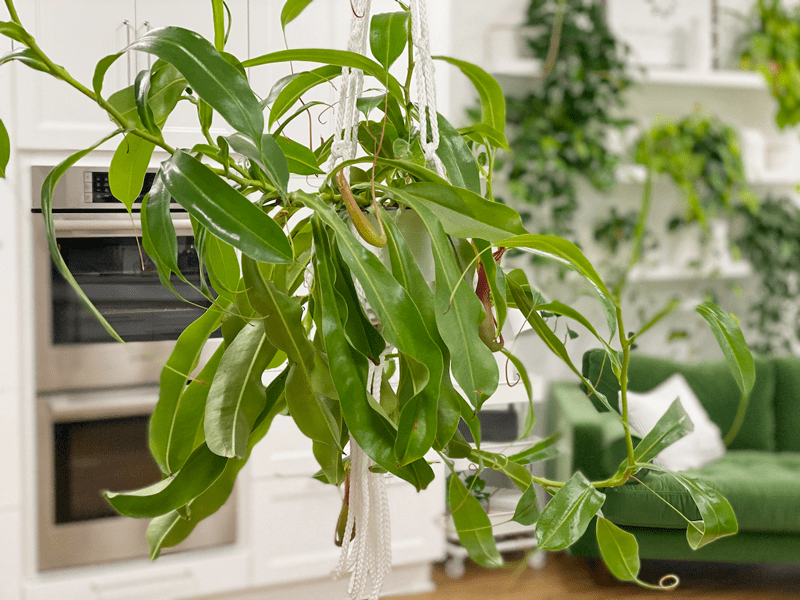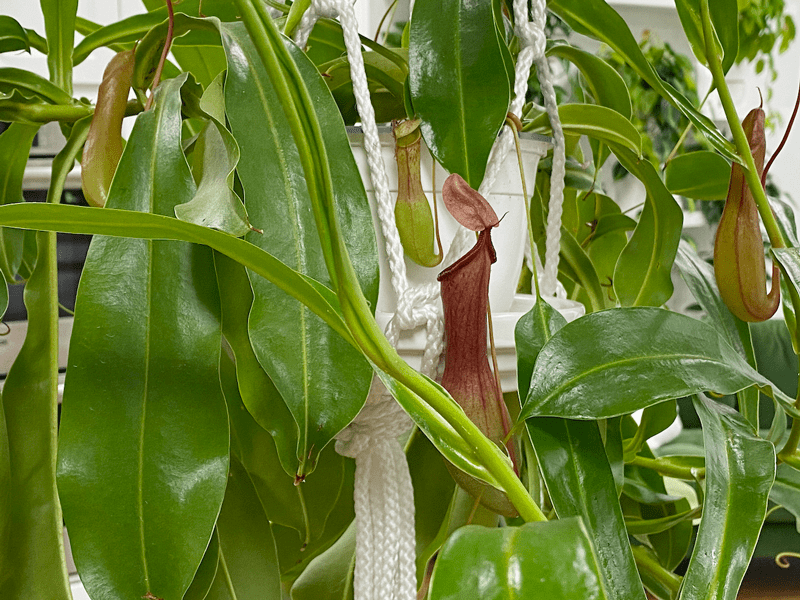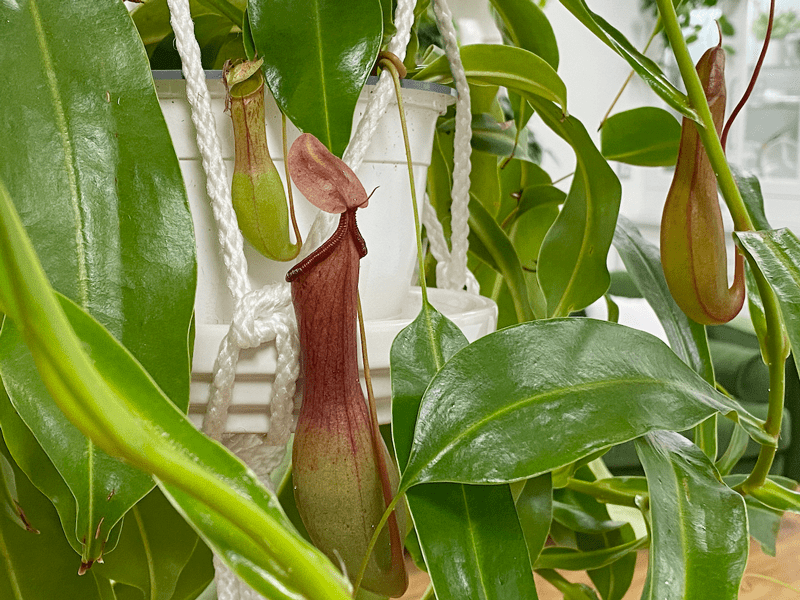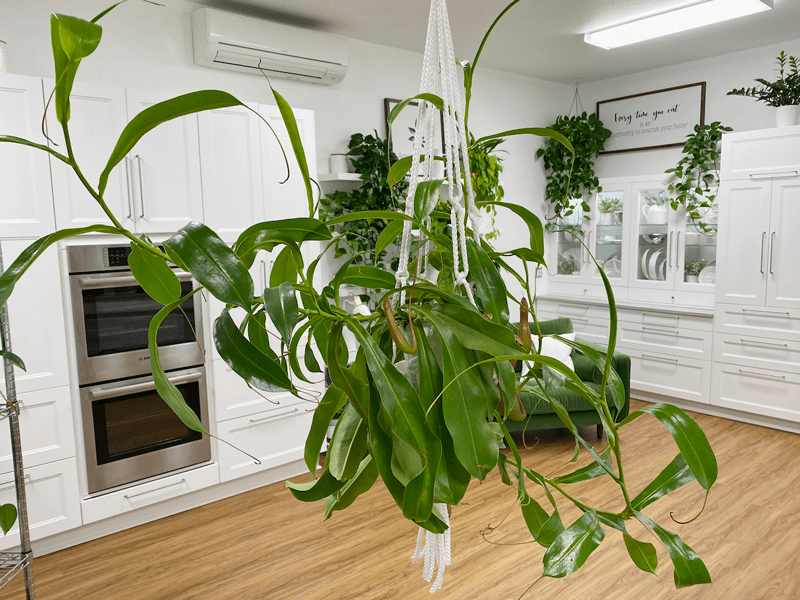

 Add to favorites
Add to favorites
This unusual plant is definitely a conversation piece. If you have a fly or gnat problem in your home, this will surely help. Insects are naturally drawn to these plants and are lured into their pitchers, where they become trapped and eventually digested by the plant.

Nepenthes is native to the highlands of Southeast Asia and is found in areas with nutrient-poor soil, which caused the plant to adapt; it digests insects caught in its pitchers to feed itself. Pitcher plants enjoy staying consistently moist, and like bright indirect light. With a little care, they will become a great addition to any space. They are also known as “Monkey Cups” because in their natural habitat, monkeys occasionally drink the fluid in the pitchers.
These plants prefer a hanging pot rather than a tabletop. They like to vine and hang, so giving them ample room makes for a striking appearance. I categorized this plant as moderate care difficulty due to its humidity needs, but otherwise, the plant is easy to care for. You will learn more below about why humidity is key.

Nepenthes are slow growers during their first few years and can take 5 to 10 years to mature. Once established, they will begin to vine and grow rapidly. At this stage, trap stems will loop around and cling to any available support. Right now, ours are wrapping around the macrame string which it is hanging from. Be sure to provide ample support for the plants during this vine-growing stage. Flowers can occur on the tips of the growing vines, and it is recommended to remove them, since they take quite a bit of energy to grow. We have yet to experience any flowers on ours.
Carnivorous plants require water that is low in minerals; therefore it is best to use distilled, reverse osmosis, or rainwater. Regular municipal tap water, well water, and bottled water will kill most carnivorous plants. Top-water weekly, or whenever the moss starts to dry. Avoid standing water, as this can cause root rot and can make them susceptible to pests. If the pitchers don’t have any water in them, add a small amount (1/2″ of water) in each pitcher. I find that I have to add the water to my indoor pitcher plant, since it isn’t outside to collect rainwater. I use an eyedropper for this.
All carnivorous plants require bright INDIRECT light. They will not produce carnivorous traps unless they are in bright indirect sun. Nepenthes thrive under grow lights, so keep that in mind as an option.
Never use commercial potting soils for carnivorous plants. These often contain fertilizers or other minerals and are dangerous for your pitcher plant. Whatever plant media you decide to use, make sure that it is well-drained and open enough, so air reaches the roots. Speaking of roots, if you ever repot your plant, don’t be alarmed by their blackish fine roots. Plant parents aren’t accustomed to such coloring for healthy roots. Also, the best types of containers are plastic or ceramic pots that have drainage holes. The excess water must drip out. When replanting, here are some options:
If you are comfortable in jeans and a t-shirt, your Nepenthes is comfortable. Daytime temperatures should be about 75 degrees (F) and at night it can handle temperatures between 50-70 degrees (F).
Pitcher plants also thrive with humidification, so you either need to place them in a space that has adequate humidity, or you may need to supplement. Our plant has been living for well over a year in our sunroom, which receives light from all 4 walls. This room is the warmest room in the house, which keeps the humidity naturally higher than our other rooms. It’s also important to keep in mind that stagnant air can lead to fungal diseases, so it’s best to have some air movement for most plants. We have a ceiling fan that keeps the air moving around all the plants in this room.
Bugs are fertilizer for carnivorous plants, and they don’t need much. Plants grown outdoors will catch plenty of prey by themselves. Indoor plants will also catch some. If you’d like to feed your plants, it’s best to feed them bugs (like swatted flies, or freeze-dried mealworms). Bob feeds our plant dead flies that he finds on the windowsills. Indoors, they will attract and capture an occasional fly or another insect. Insects are attracted to this because of nectar secretions found within the cups. The slippery opening and inner walls of the pitcher encourage insects to fall into the digestive fluid at the bottom of the trap. Nutrients are absorbed from this “soup.”
Fertilization is not necessary; however, an occasional, summer application of orchid food, diluted 10%, will benefit growth. Nepenthes respond well to foliar fertilization. Spray twice a month during the growing season with a dilute (10%) orchid fertilizer.

If you would take a moment to really look at the photo above, I’d like to point out a few characteristics of this plant. #1: If you look at all three monkey cups, you will notice that they are at various growth stages. The far-right one hasn’t opened its lid yet. #2: As I have mentioned above, these plants vine in their natural habitat. If you look at the top center of the photo you can see that the tip of the plant has vined out and is wrapped around the plant hanger cord. #3: If you look at the largest monkey cup in the photo, you will see a “shadow” or a darkening in the belly of the monkey cup…that is the water/food line which shows how much stuff is inside of it. Pretty cool stuff, if you ask me!

As of today, this plant measures 3 feet wide x 3 feet tall. It currently has 6 monkey cups.
Very knowledgeable, thank you for the guidance.
You are welcome Fredi. :)
I love the info you gave. I just purchased 3 very small alta plants. Can I put all three together and what size pot do you recommend for them as a threesome or what size if planted separately .
Good morning Sue,
I am so glad that you found the information useful. :) You can definitely plant all three together if you wish to. We did that last year, but with two and they are thriving. As far as recommending a pot size… it depends on how big they are. I know you said “very small”… so my guess would be perhaps a 6” pot. If you want to email me a photo of all three of them, I can better determine the right size. [email protected].
blessings, amie sue
Hi Amie Sue,
I hope you’re well. I just purchased this plant online via Amazon. It came in nicely and is flourishing. I will continue to reference this page, so I can take really good care of it as I have this specific species. I live in Seattle though it is summer time now, I’ll have to create humidity for the cooler temperatures and probably get a grow light.
Thanks for making this easy!
Good morning Aja,
Thanks for leaving a comment. The pitcher plants are fun to have. The pitchers may be slow to growing but when they start, it brings a certain excitement with them. Enjoy! blessings, amie sue
We live on the east coast of Florida just south of Cape Kennedy. We bought a small Nepenthes Pitcher Plant about 4 years ago. we have since split it into two and now need to split those two into two each again.
We found that using distilled tap water and captured rain water has made a large difference it their growth. We have 100’s of picture between the two plants and two months ago the bloomed with 7-8 branches of blooms but were on a month trip when they bloomed.
they are in hanging pots and get morning to mid afternood direct sun. we have them in potting soil with sphagnum moss on top. Since we live next to a marsh, they get plenty of bug food.
Now we are trying to raise new ones from the 1,000’s of seed pods.
hope others are having sucess as we are. The do get big.
Hey thanks for sharing your experience David. You live in the perfect conditions for these types of plants to flourish! amie sue
Thank you for this information, it is very helpful. I just purchased my first pitcher plant. It came with only one pitcher that was likely damaged during shipping. Do I need to worry that it doesn’t have a source for food? Is there anything I should do to feed it until the next growing season? Thank you.
Hello Mitch,
Congrats on your new plant. We really enjoy our pitcher plants. Many people say that you don’t need to feed them anything but we do. I think my husband gets a kick out it because he feels like he is really “taking care” of it by doing so. We add a little water to each pitcher cup and whenever we come across a bug, he picks it up with tweezers and puts it in the cups. Last year, we had a LOT of box elder bugs so those cups were getting their fill. This year, we haven’t had hardly any so they haven’t been getting any bugs. Both ways have produced happy plants. Each year we get lots of pitcher cups despite whether we feed them or not. Bob does have some dried bugs (bought off Amazon) that he likes to put in the cups. If you get some, just make sure they aren’t flavored or have salt on them (they do make them for human consumption).
I hope this helps. enjoy! amie sue
Thank you for this information. But my question is what to do when there are no pitchers (due to damage from shipping). Is there anything I should do between now and the next growing season?
There isn’t anything to really do except water it and make sure it is getting adequate light. amie sue
Okay, thank you.
I have a very large plant in my greenhouse and would like to start new plants from it to give to friends.How do I root cuttings?
Such great timing because we are propagating our Nepenthes as well. There are quite a few steps (easy ones) in order to propagate these plants. So instead of trying to type it all out, I looked for an informative video for you: https://www.youtube.com/watch?v=CkJx7ZK2ovY
Good luck! I wish you many successful baby plants! amie sue
I bought my first Nepenthes Alata a few weeks ago and immediately repotted it in long strand sphagnum moss and perlite. It arrived in a small pot, containing shat appeared to be dark brown mud. I mist it several times a day with distilled water. It has one old pitcher, two fully formed, one small one (about 20mm long) which has increased in size by about 50% in the last three weeks and two very small ones which are slowly increasing in size and it has a new leaf which, at the moment just looks like a spike growing from the centre of the plant. Because of my ignorance and bad advice, I have put it in direct sun for several hours per day on a south and west facing windowsill (moving it as the sun goes round) and ‘topped up’ the hours of sunlight with a white LED grow light. The newer pitchers have turned a much deeper red and there is a slight reddish tint to the leaves. Have I sunburned the plant and if so, will it recover? I live in the south of England, latitude about 51 degrees north so daylight hours are reducing. Thanks.
Good morning Bob,
Thanks for reaching out and sharing your experience with me. Without seeing the plant, it sounds like the leaves did indeed get sunburnt by receiving too much direct sunlight. Those sunburnt leaves won’t revert back to healthy ones but you can remove them and save the plant by moving the plant farther from the light source. I would also guess that because you were misting it while it being in the direct light… that it intensified things. I’ve never misted ours over the years.
Other than being sunburnt it could have to do with indicating inadequate phosphorus (the leaves turn a more deep red color. These plants get phosphorus from the insects they attract and digest. They use phosphorus from insects to augment the green chlorophyll in its leaves for photosynthesis. IF the plant isn’t getting enough nutrients, you can add small insects to the mature pitchers.
I would start by relocating the plant so that it is only receiving indirect light. I have mine been in a south-east facing window and it’s been hanging there for years. It’s not hanging directly in the window though. I have tall floor-to-ceiling windows with about 2 feet of wall space between them… it is hanging in front of the wall that is snugged between two windows.
I hope some of this helps and I wish you the best! amie sue